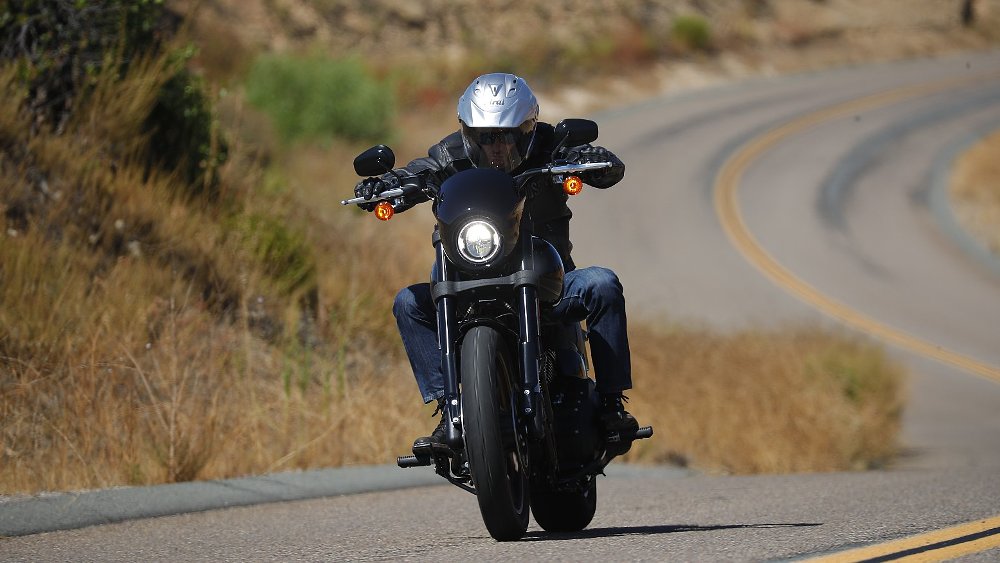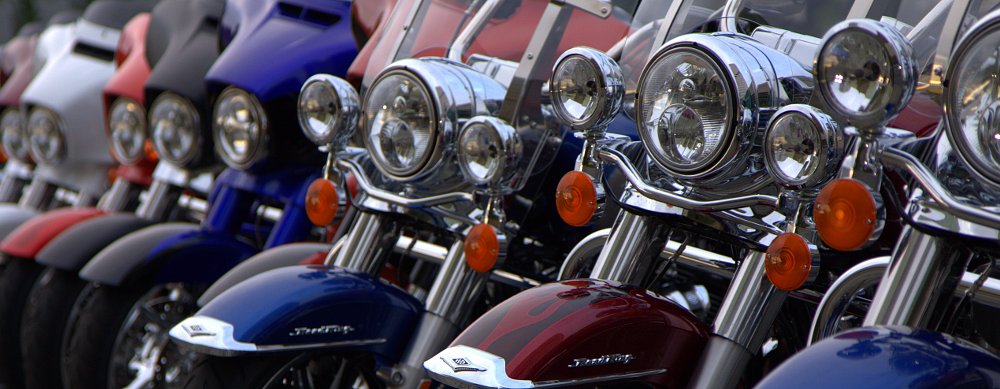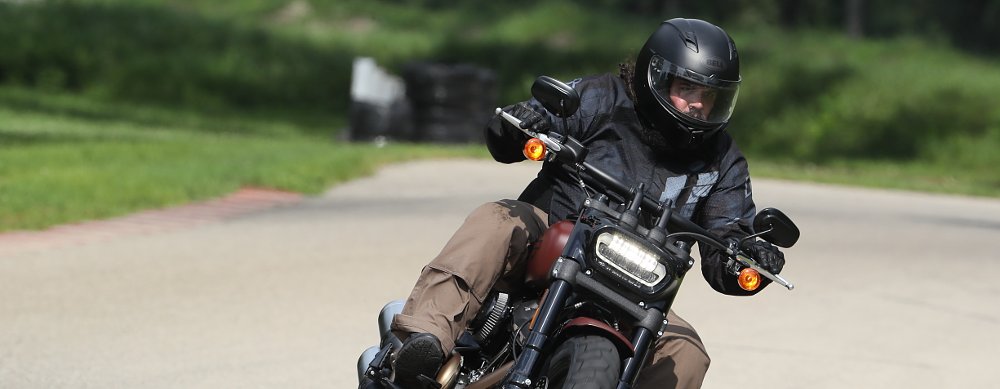Harley-Davidson has a checkered (recent) history when it comes to sporting motorcycles.
Sportsters have kept about the same performance envelope while the motorcycle world got faster. Customers rejected the underrated XR1200, which was an effort to put the “sport” back in the line. But there's another Harley with "Sport" in the name: the Sport Glide. It's still a cruiser with a profile familiar to H-D’s core customers. My question was, what does “sport” mean in that context?
My education began at Harley-Davidson’s original factory on Juneau Avenue in Milwaukee, which was eerily quiet due to COVID-19 and a responsible strategy of having almost all head office employees work from home. H-D Senior Manager of PR and Communications Paul James gave me a quick rundown on a 2020 Sport Glide.
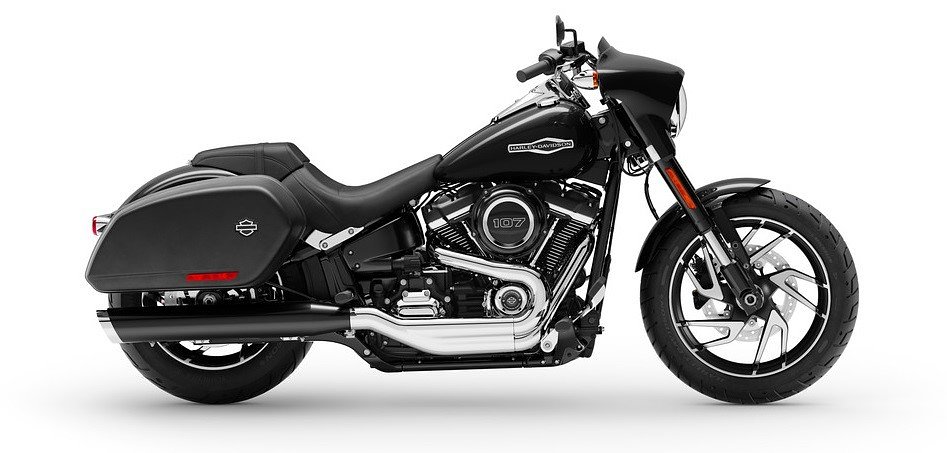
The dash and electronics are minimal; there’s a large analog speedometer, gear indicator, and one multifunction display that can show fuel level, range remaining, or a trip odometer, but I left it in tachometer mode. The display sits on the fuel tank, so you really have to look down from the road to see it. There are no ride modes to program or anything like that, so the briefing mainly consisted of showing me that I could remove the small batwing fairing and the saddlebags without tools if I wanted a stripped-down cruiser look. (The fairing and bags are stock items, not optional; the bike I rode was stock except for upgraded orange paint.)
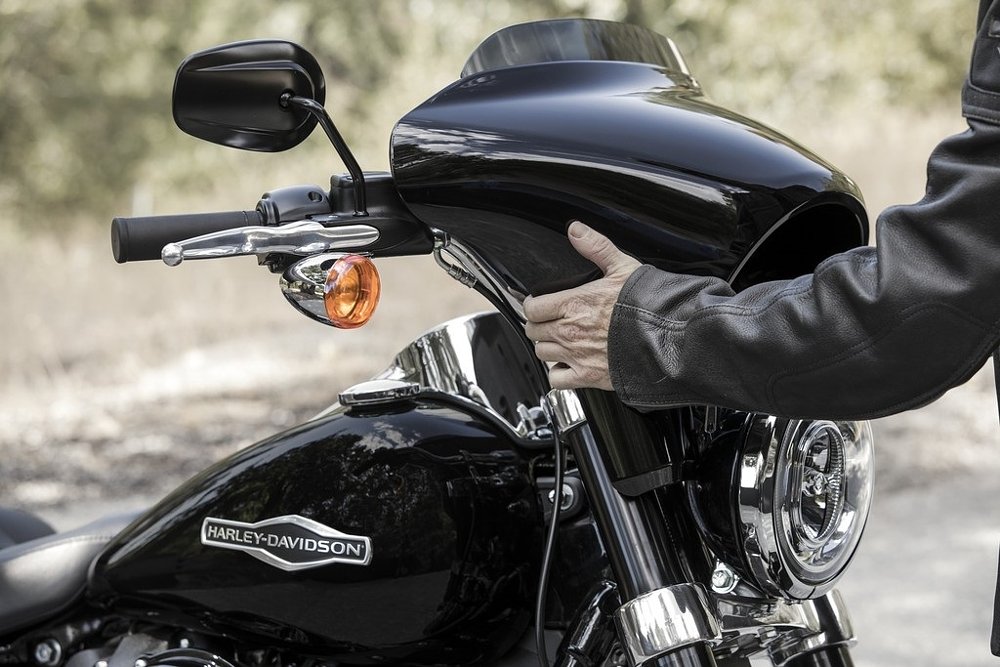
The Sport Glide comes with one engine only, the 107 ci Milwaukee-Eight, which is basic to the the Softail line. But it’s distinguished from most of the other Softails by a 43 mm Showa inverted fork.
An inverted fork alone isn’t enough to make the Sport Glide read as a “sport” motorcycle to me, but it struck me as a clean, handsome machine. The saddlebags are nicely integrated into the overall lines. A fairly large oil cooler’s inconspicuously tucked between the frame downtubes, creating an old-school, air-cooled impression that drew some approving glances and comments.
James told me that Harley thinks of the Sport Glide as a do-everything bike that can handle any assignment from an urban commute to light touring. (Indeed, just a week earlier, I saw a Sport Glide with New York plates parked in front of the company Museum. That rider had optioned it up with the taller windscreen, a luggage rack, and tailpack.)
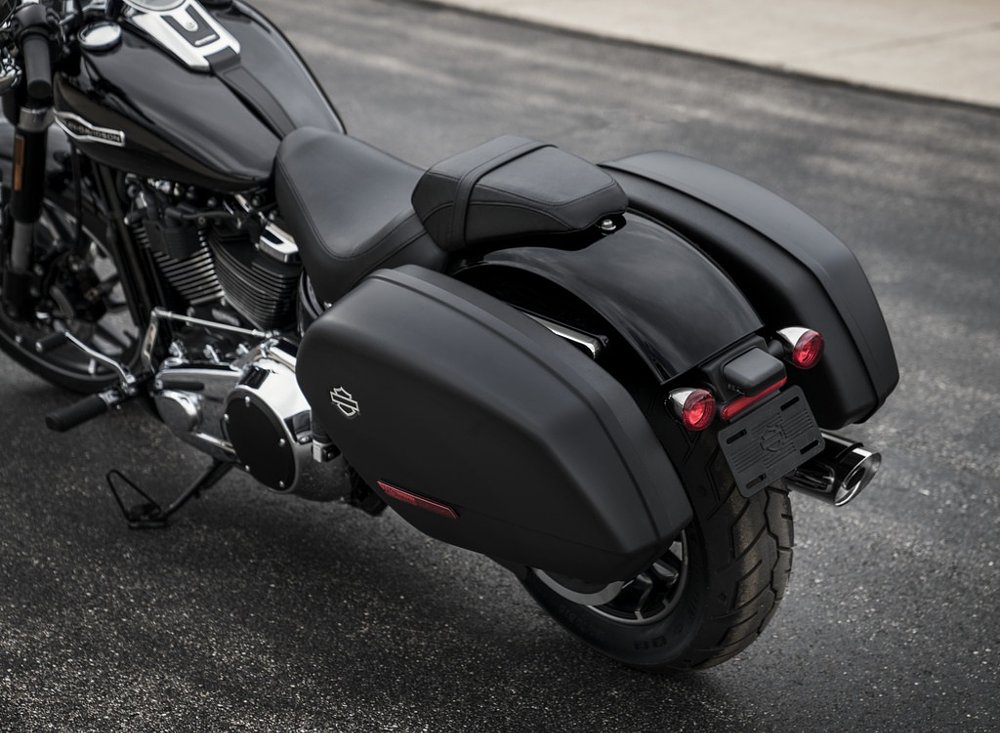
The Sport Glide comes with a proximity fob, but it was disabled on my press loaner. Maybe they’ve learned from experience that anything a journalist can lose, he will lose! I was just given a key for the steering lock. Without further ado, I was free to go. Luckily, I caught some of the last really warm days of the riding season in Wisconsin.
The road to Elkhart Lake
In order to get a sense of just how “sporting” the bike might be, I took it up to Elkhart Lake to cut a few laps. Not of Road America — that would have involved a too-delicate phone negotiation with H-D up front, or put me at risk of an even more awkward conversation if the Sport Glide was dripping gravel when I dropped it off a week later. Instead, I rode a few laps of the original Elkhart Lake road courses, which are now listed on the National Register of Historic Places. That involved open roads and speeds a bit more appropriate to the machine, anyway.
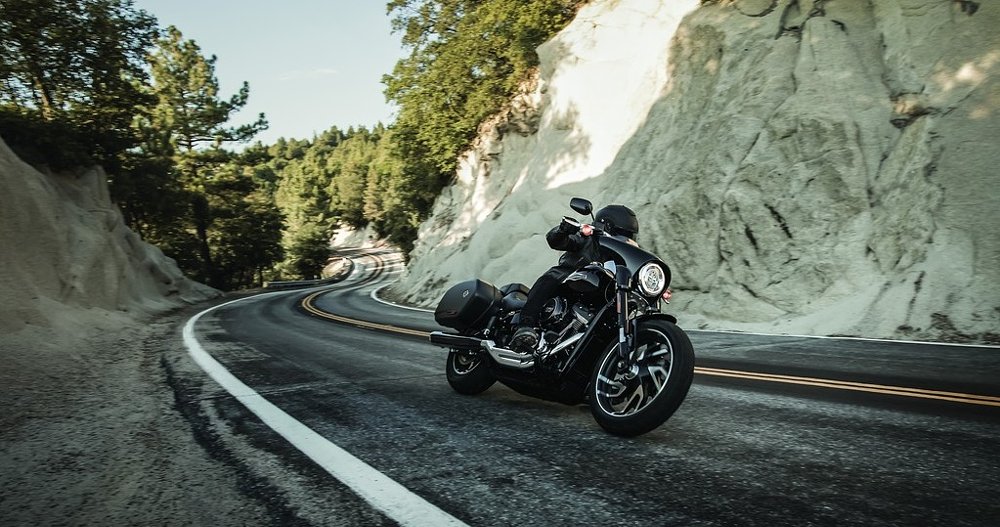
The route from my place in Milwaukee to Elkhart Lake included a mix of pretty much every kind of road Harley-Davidson could’ve had mind for the Sport Glide. I started off on the gritty urban streets of one of America’s most segregated cities (complete with a brief appearance by a gang of stunters on motocross bikes). On those rough, potholed urban streets I would have preferred more than 3.4 inches of rear suspension travel and/or mid-mounted controls that would at least let me raise my butt off the seat. A plus, though, was the remote access preload adjustment. I dialed almost all the preload out of it and pressed on.
Other than that, it was a doddle around town. I didn’t notice the clutch pull. First gear’s really low and the engine produces almost 110 foot-pounds of torque at under 3,000 rpm, so even though it weighs 700 pounds, the Glide leaves red lights quickly and requires a quick first upshift. Once underway, it will chug along in city traffic much more happily, and with far less shifting, than a proper sport bike.
Next, my route took me up about 40 miles of Interstate. Northbound, I cruised along in the right lane, paying attention to how much effort I expended holding myself up in the wind. I started to feel wind pressure on my helmet at around 70 miles an hour, so I held it at that speed for while, which worked out to just under 2,700 rpm in sixth gear.
At that speed, I really couldn’t feel any vibration from the rigidly mounted engine; it’s an impressive achievement by the engineers. Even the mirrors are rock-steady. After leaving Interstate 41, Wisconsin State Highway 45 dropped from a divided four-lane to a smooth, flowing two-lane road through Kettle Moraine State Forest. I started to see quite a few motorcycles. It wasn’t technical riding and the sweepers would not have been challenging at any speed the Sport Glide could achieve. But it was still fun.
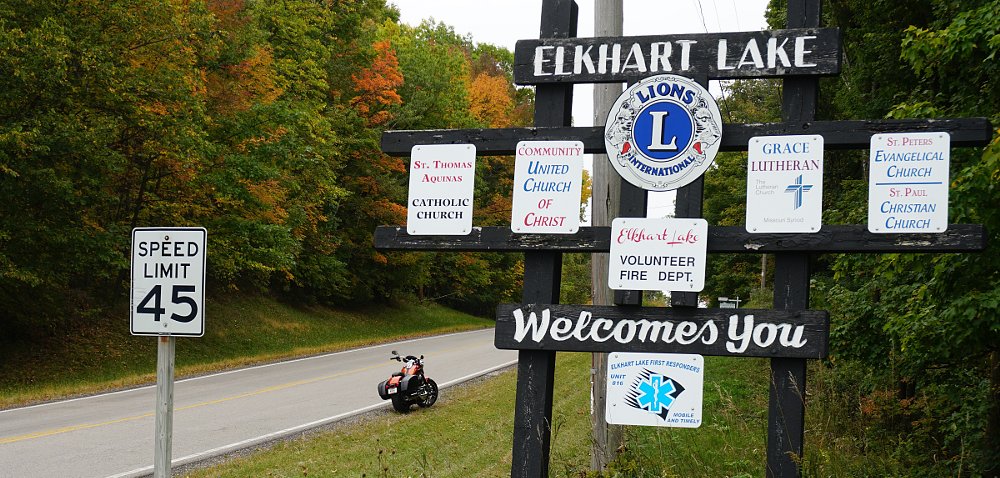
Road racing in America
The story of the original Elkhart Lake road races begins in the late 1940s. U.S. soldiers saw sports car and motorcycle racing return to European roads after the war and they brought the idea back to America with them.
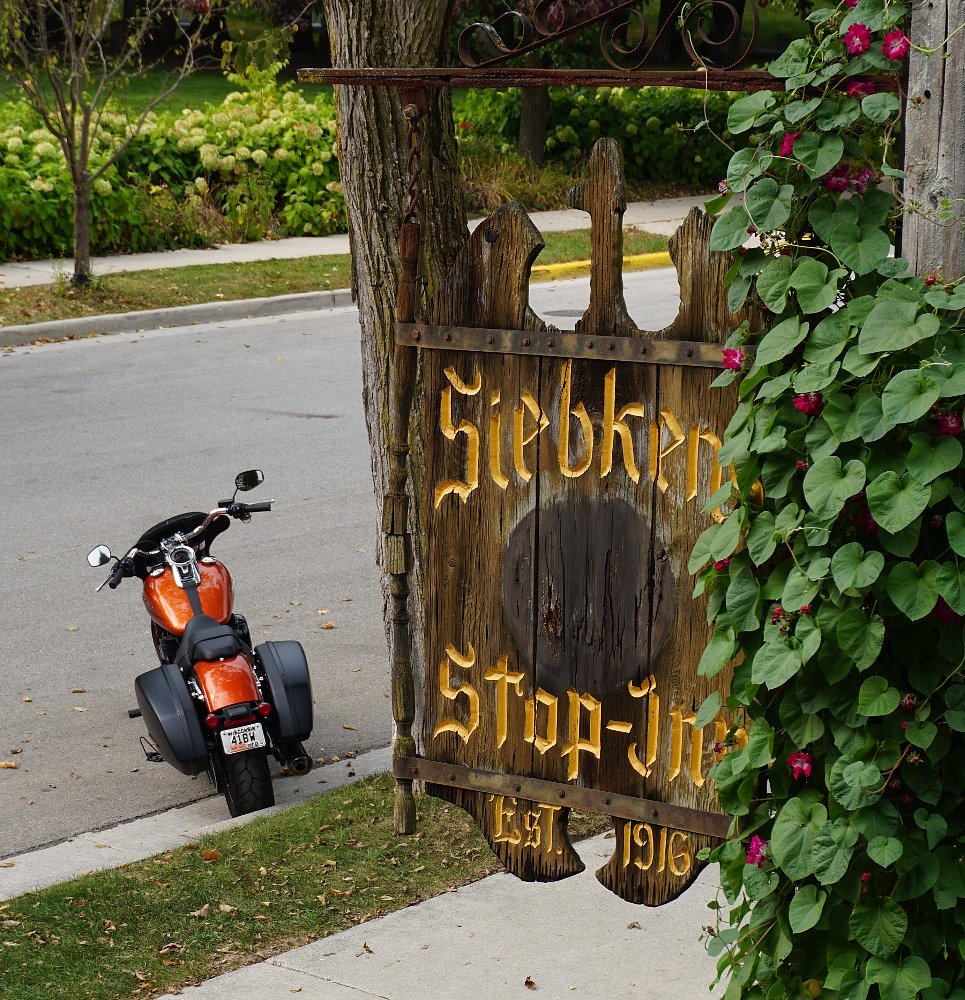
The first races took place in July 1950. The event was headquartered in Elkhart Lake but the roughly triangular 3.5-mile course was laid out on roads north of the town proper. Thirty-three cars competed in four classes, drawing a reported 15,000 fans.
It was such a success that the next year, organizers laid out a longer course around the lake and put the start-finish line right in town. At the last minute, racers protested that County Road X was too dangerous. The rolling and daunting green mile had been part of the 1950 course and although no one was killed, there had been some scary crashes. The course was hastily redrawn, resulting in a 6.5-mile route that presented fewer driving challenges but more mechanical ones.
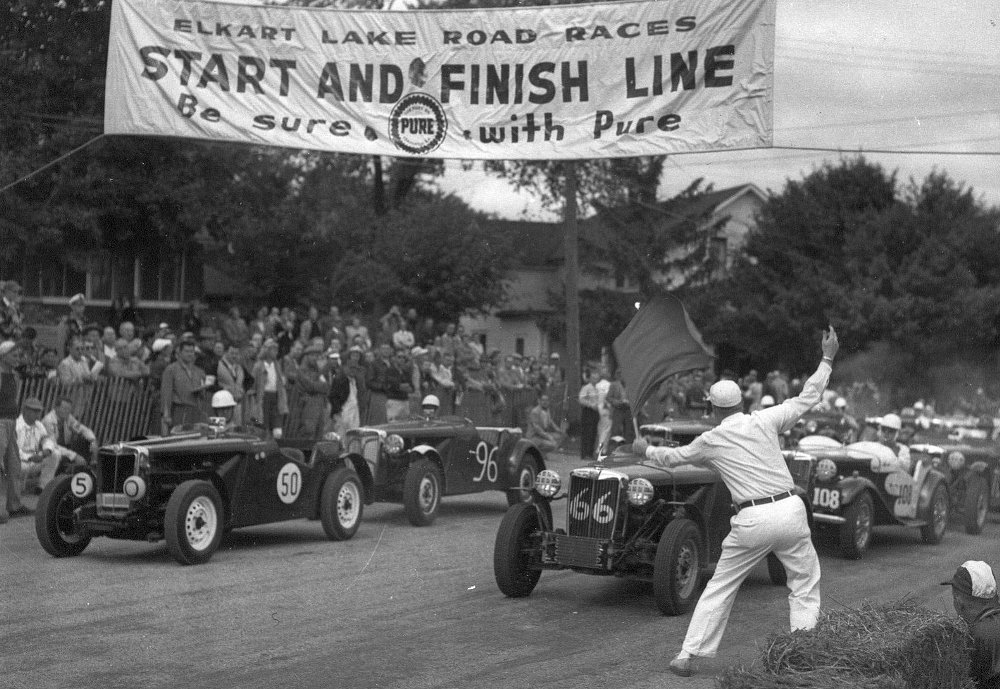
Although they only ran two classes in 1951, there were 98 entrants and the event drew an estimated 75,000 fans. (Attendance figures are estimated, because there were no tickets sold. The cost of putting on the races was mainly recouped by charging for parking and selling programs.)
The 1952 event was staged on the same course over two days. According to the large informational plaque on the town’s main street, there were 238 entries in three classes. European thoroughbred race cars — Ferraris, Allards, and Jags — battled with American Cunningham cars. One of the drivers was Phil Hill, who went on to win the F1 World Championship, as well as the 24-hour race at Le Mans. When 175,000 fans showed up, the Elkhart Lake road races seemed poised to over-deliver on the promoters’ promises.
Unfortunately, the same kind of thing was happening in upstate New York State, and in the 1952 races at Watkins Glen, Fred Wacker — one of the Elkhart Lake organizers — crashed into spectators, killing a child and injuring several other people. The Watkins Glen tragedy pretty much rang the death knell for racing on public roads in the United States. (Luckily, Elkhart Lake rallied around the idea of a purpose-built road course with better safety for competitors and fans, and Road America opened for racing in 1955.)
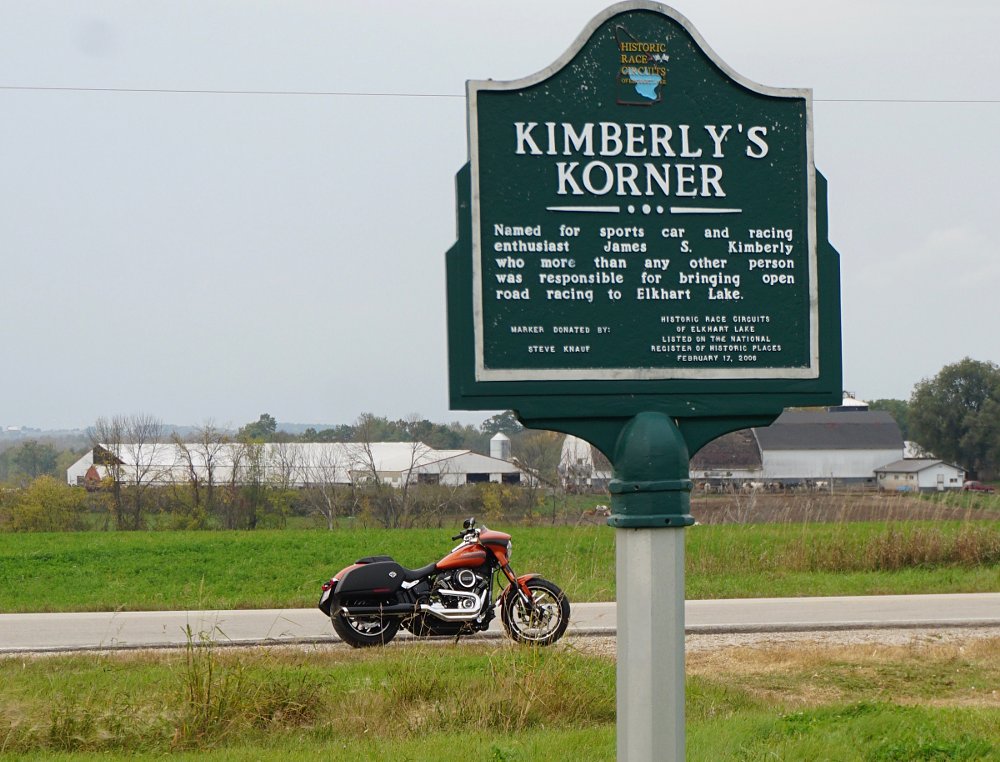
Riding the Sport Glide on the old road courses
The historical marker for the start-finish line of the second (longer) course is near a building that used to be a mill but is now a road house, and a number of bikes were in the parking lot. The Sport Glide prompted a few questions. I’m not sure if curiosity was piqued just because of its “Scorched Orange/Silver Flux” paint scheme ($1,150 upcharge) or because people aren’t familiar with the model, despite it’s having been on the market for a couple of years. When I told one guy it was a Sport Glide he asked, “So, it’s the new Sportster?”
I had a map of the old courses, but between my geographical dyslexia and the fact that a few hundred yards of the course are no longer a road, it took me a while to get sorted. My plan was to ride the proposed long course, then the actual long course, and finally the original short course.
I set off from the start line, turned right onto Lake Street, past Siebken’s, to “The Hard Left.” At this point the course took a long sweeping right along the lakeshore, but that is now a pedestrian zone through the tony Osthoff Resort. So I left the course for a few blocks and reconnected with Lake Street, before turning right onto County Road JA, aka “Wacker’s Wend.” It’s not a straightaway, exactly, but would certainly have been taken flat-out in the cars of the day. It would have been fun to take it flat-out on the Sport Glide, too, but there was enough traffic, including a fair number of bicyclists, to make that pretty anti-social.
After the fast and flowing “Hamill’s Hollow” section, named after the husband and wife racers Corky and Joan Hamill, comes the mile-long “Schoolhouse Straight,” which was a test of mechanics and metallurgy, but not of the drivers. I took advantage of breaks in traffic and good sightlines to run the Sport Glide up to 90 plus mph there. Although there was definitely more to come, with a bit less than 80 horsepower pushing a fair amount of air, it was going to come slowly.
Schoolhouse Straight ended at the right-angle “Kimberly’s Korner.” In a more sporting situation, Kimberly’s would have been a great test of the Sport Glide’s brakes. I’ve read that Harley-Davidson’s designers so love the bike’s 18-inch front “Mantis” wheel that they wanted it to be fully visible from one side. Be that as it may, the single 300 mm disc and four-piston caliper setup was always adequate during my week on the bike. H-D fits levers that have a wide “pressure zone,” which makes it easy to squeeze the front brake quite hard, and I often wondered whether the amount of pressure I was using would have either locked up a sport bike’s front wheel or raised the rear wheel.
Stoppies are not a risk on a bike as long and low as the Sport Glide. There’s always a lot of weight on the rear, so the brake pedal contributes meaningful stopping power. FWIW, I never felt the ABS kick in. The brake lever is not adjustable for hand span; that might be a good feature to consider, given Harley-Davidson’s focus on female customers.
Another long straight led to “Dickens Ditch,” named for Sid Dickens, who left the road here in his MG-TC. This is the beginning of a lovely flowing section that would be fun at crazy-fast speeds, except for the fact that it also includes a busy boat launch, so there’s guys pulling trailers on and off the course here. This was a spot where I appreciated being on a motorcycle that wasn’t constantly egging me on, and snickering at me because I wasn’t dragging my knee through 120 mph sweepers.
I digress. Where was I? Oh yes, coming up on CR JP, which in the ’50s was known by the more intimidating name County Road X. I headed east there, to cover the part of the course that drivers had rebelled against. I understood their trepidation, but it was also by far the most fun stretch. The trickiest bit, for sure, would have been “Briggs’ Bend.” Imagine racing through Road Atlanta’s infamous “Gravity Cavity” but in the reverse direction, with 10 feet of runoff into a dense forest.
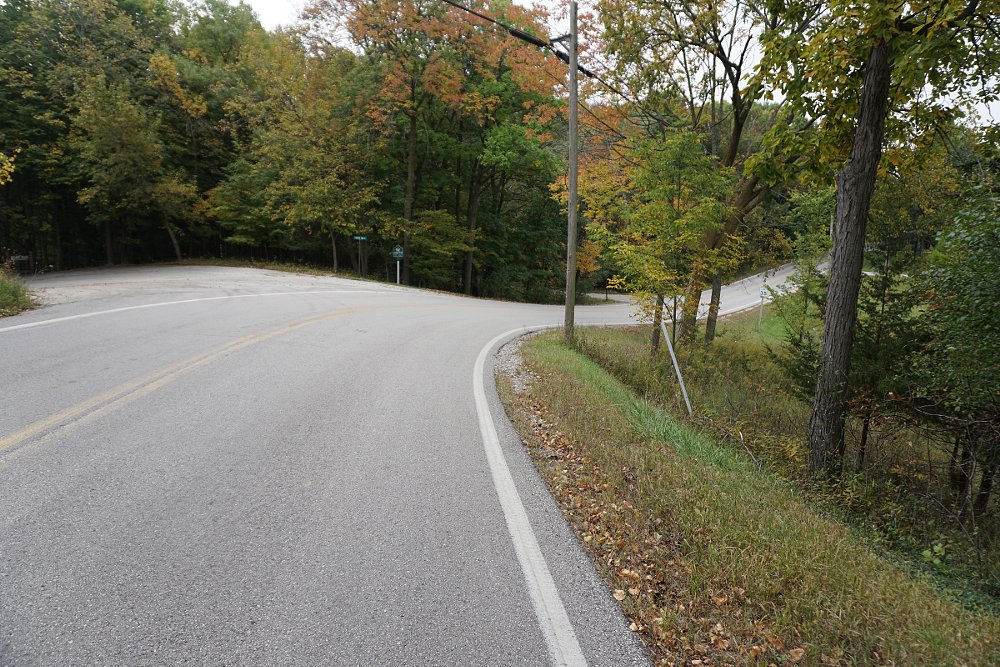
At that point the proposed 1951 course would have turned right, off CR X onto Gottfried Street, where racers would pass under the start-finish banner. On my next lap, I skipped the turn towards Briggs’ Bend, following the course as it was actually used in ’51 and ’52.
So, I continued north on CR P, past the 1950 Start-Finish line on another long engine-busting straightaway ending in a tricky, long right known as “The Marsh Turn” back onto CR J. I imagine a few racers were grateful that this was one of the few spots on the course with meaningful runoff. CR J, now also known as Kettle Moraine Scenic Drive, turned into Gottfried Street.
The 3.5-mile 1950 course was the most fun. It started on a long straight stretch of CR P, turned right at The Marsh Turn, leading to “Ted’s Turn” — another 130-degree right that was, unfortunately, strewn with gravel the day I was there. That put me on the old CR X road, which was in fact part of the 1950 course, but it was run from west to east in that first year. In that direction, Brigg’s Bend is a fast cresting and dropping right that would really separate the sheep from the goats.
In that setting, the leverage provided by the Sport Glide's wide handlebar was a match for its long wheelbase, mass, and 30 degrees of rake. The new (in 2018) Softail frame’s stiffer and lighter than Harley-Davidsons you may have ridden. Writing as a sport bike rider, turn initiation would be improved by mid controls; they’d make it easier to brace your body when countersteering. But the design brief specified a low seat height and mid controls would limit cornering clearance.
As it is, the bike will lean almost 30 degrees before dragging anything. The first points of contact are the rider’s heels; perhaps because of that sub-27-inch seat, it feels as if the bike’s really banked over before that happens. The H-rated proprietary bias-belted Michelin Scorcher tires seemed to provide good grip on both cold and wet and warm and dry asphalt.
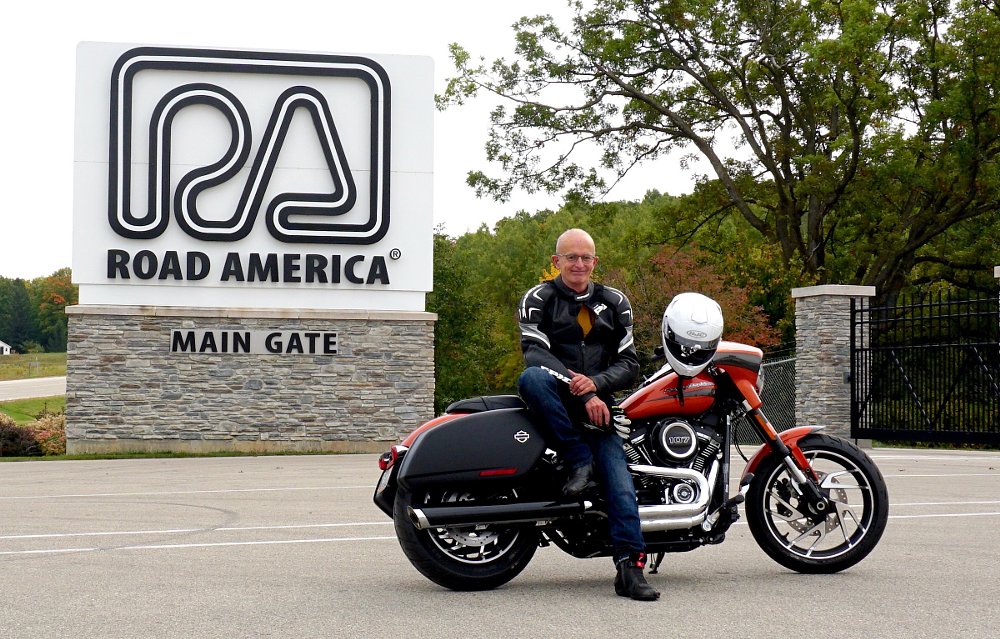
“Whaddaya say, sport?”
On the way up, I’d decided that 70 mph was comfortable, in terms of wind blast. On the way home I was like, 90 is also fine but I wished for a rider triangle that would have made it easier to lean into the wind. H-D’s accessory catalog offers a set of controls reduce the reach to the footpegs by an inch. They might be a bit better for me.
Although I like the look of the baby batwing, I would choose the taller windscreen for light touring. I returned the Sport Glide to Harley in a cold rainstorm. That experience prompted me to check the accessory catalog for a wider batwing that would keep wind and rain off my hands. There’s not one. (Heated grips are available, of course.)
The five-gallon tank also suggests that H-D wanted this model to have decent touring potential. It’s not surprising, considering how tidy they look, that the saddlebags are pretty small. Getting them on and off is a bit fussy because the release is inside the saddlebag. That said, I really like the positive closure and the fact that they can be securely closed without being locked.
My week with the Sport Glide was my longest-ever flirtation with cruiser culture. Am I a convert? No. But thanks to its overall usefulness and enjoyability, it’s easier for me to relate to cruisers than it used to be.
I found myself defending the Sport Glide to my ex-racer friends (many of whom have now graduated to ADV bikes.) They think that 30 degrees of lean is where the fun starts. Maybe, but this is a cruiser with a frame, suspension, brakes, and tires that can cash any check the motor can write. Choose your battles, I argued, and you’ll embarrass a lot of kids on sport bikes.
Despite that defense, on cross-examination I had to admit that it’s not really a “sport” motorcycle. It’s still a cruiser, but it’s one that can easily handle a commute with a sack lunch and a laptop or an overnight trip of a few hundred miles and is surprisingly competent on a curvy road.
The base model, in black, lists for $18,599. There are far more versatile and competent motorcycles made in Japan or Europe that sell for (much) less. But many of them look like bugs or transformers. If you have your heart set on a long, low American V-twin, the Sport Glide is a proper motorcycle, disguised as a cruiser.
| 2020 Harley-Davidson Sport Glide | |
|---|---|
| Price (MSRP) | $18,599 base, $19,749 as shown |
| Engine | 107 ci (1,746 cc), air-and-oil-cooled, eight-valve, V-twin |
|
Transmission, final drive |
Six-speed, belt |
| Claimed horsepower | N/A |
| Claimed torque | 108 foot-pounds @ 2,750 rpm |
| Frame | Steel tubular |
| Front suspension | 43 mm inverted cartridge fork; 5.1 inches of travel |
| Rear suspension | Single shock, remote preload adjuster; 3.4 inches of travel |
| Front brake | Single four-piston caliper, 300 mm discs, ABS standard |
| Rear brake | Two-piston caliper, 292 mm disc, ABS standard |
| Rake, trail | 30 degrees, 5.9 inches |
| Wheelbase | 64 inches |
| Seat height | 25.7 inches (laden) |
| Fuel capacity | 5.0 gallons |
| Tires | Michelin Scorcher, 130/70B18 front, 180/70B16 rear |
| Claimed weight | 670 pounds dry/699 pounds wet |
| Available | Now |
| Warranty | 24 months |
| More info | Harley-Davidson.com |

 Membership
Membership








